Harry Lauder's Walking Stick
.jpg) |
| Corylus avellana 'Contorta' |
This is a plant, it seems, that no one is one the fence about. Either you love or hate the contorted large shrub that is known as Harry Lauder's Walking Stick (though it always looked like a wand from Harry Potter to me). Corylus avellana 'Contorta' struggles in the heavy clay soils and dry winters of most of Colorado, it thrives in most climates. This cold hardy, corkscrew version of the popular hazelnut was found in a hedgerow in England in the mid 1800s. It is primarily grown as a novelty plant. In the summer, the rather large leaves hide the twisted nature of the plants and it generally appears as a rough green mound. This is a plant used mainly for winter interest.
So, who is this Harry Lauder for whom this odd plant was renamed?
So, who is this Harry Lauder for whom this odd plant was renamed?
 Sir Harry Lauder was born in Scotland on August 4th, 1870. Early in his youth, his father died and his family moved to be near his mother's relatives. There, in Lanarkshire, Lauder first worked in a mill then in a coal pit. This is when he first developed his talent for singing and comedy. He sang folk tunes and funny songs to his fellow workers to bolster there spirits in the dark, dusty pit. They enjoyed it so much that they encouraged him to sing in the local taverns. He gained some local fame and soon joined with a concert party that toured the country.
Sir Harry Lauder was born in Scotland on August 4th, 1870. Early in his youth, his father died and his family moved to be near his mother's relatives. There, in Lanarkshire, Lauder first worked in a mill then in a coal pit. This is when he first developed his talent for singing and comedy. He sang folk tunes and funny songs to his fellow workers to bolster there spirits in the dark, dusty pit. They enjoyed it so much that they encouraged him to sing in the local taverns. He gained some local fame and soon joined with a concert party that toured the country.Irish comedians were the favorites of the time, so Lauder based his early act on that. He became known for wearing full Highland regalia and carrying a crooked walking stick in his act. He toured the world and had many hit songs, always playing up his Scottish heritage to great effect. A collection of recording of his music can be found here:
http://archive.org/details/HarryLauder
Though he is best known for being a jovial Scotsman, he was in fact a versatile and talented man. In various productions he played a wide range of roles and composed songs much more profound than the raucous pub songs that began his career.
His son, John, was killed in World War I. Harry Lauder really wished to personally help in the war effort. He was declared to old to go into battle, so he suggested he could sing to the troops and help keep morale up, similar to the day back in the coal pit.
Lauder performed for the Scottish troops in all circumstances, even disobeying the War Office to sing to the lads in the trenches. He worked to recruit new soldiers and even started the Harry Lauder Million Pound Fund which aided Scottish soldiers and sailors who were maimed in the war. It was for these efforts that he was knighted in 1919.
.jpg)
Maybe it is time to give that comical shrub a chance, or just have yourself a nice Harry Lauder cocktail and sing a few bars of "She is my Daisy".
Cocktail recipe: http://www.absolutdrinks.com/en/drinks/harry-lauder/
His son, John, was killed in World War I. Harry Lauder really wished to personally help in the war effort. He was declared to old to go into battle, so he suggested he could sing to the troops and help keep morale up, similar to the day back in the coal pit.
Lauder performed for the Scottish troops in all circumstances, even disobeying the War Office to sing to the lads in the trenches. He worked to recruit new soldiers and even started the Harry Lauder Million Pound Fund which aided Scottish soldiers and sailors who were maimed in the war. It was for these efforts that he was knighted in 1919.
.jpg)
Maybe it is time to give that comical shrub a chance, or just have yourself a nice Harry Lauder cocktail and sing a few bars of "She is my Daisy".
Cocktail recipe: http://www.absolutdrinks.com/en/drinks/harry-lauder/
Biographical information on Harry Lauder came from the University of Glasgow: Special Collections



